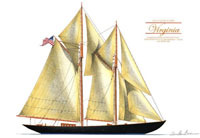 In 2007 the schooner Virginia won the great Chesapeake Bay Schooner race, establishing a record time which remains unbeaten. This year, sadly, while the other schooners raced, she remained tied to a dock in Norfolk, Virginia.
In 2007 the schooner Virginia won the great Chesapeake Bay Schooner race, establishing a record time which remains unbeaten. This year, sadly, while the other schooners raced, she remained tied to a dock in Norfolk, Virginia.
Cash-strapped Schooner Virginia appears dead in the water
The non profit foundation that owns the ship, the Virginia Maritime Heritage Foundation, is carrying $1.6 million in debt. Board members called the ship back from the Caribbean, laid it up and fired most of the paid crew in December when cash ran out.
A last-ditch effort between schooner officials and the Nauticus Foundation to get the Virginia sailing again is now under way, but many details remain to be worked out, said Will King, the schooner foundation’s now unpaid executive director.
“It’s do-or-die time for the Schooner Virginia,” said Bob Stanton, a longtime board member and founder of a commercial real estate company. “We either come up with a plan to operate it that is financially sensible or we’re going to have to face the ultimate consequence, which is to sell the vessel, pay off the debt, lick our wounds and go home. That is not what we want to do.”
If there’s a surprise in this story, it might be that the Virginia didn’t stop sailing earlier. Sluggish private fundraising, a heavy reliance on now dried-up state money and bank loans, a lack of sailing programs that paid the bills, and the sinking economy grounded the Virginia, according to interviews and a review of the ship’s financial records.
“It was touch-and-go for years,” said Palmer Rutherford, another longtime board member and retired attorney.

No surprise here. Many people want to build and operate a “tall ship” or schoolship, but their motives for doing so often sound more like excuses than reasons. This wouldn’t matter with a well funded effort where the ship didn’t have to make money and has a big endowment behind her, like Amistad. But Virginia was built with borrowed funds and government grants that were one-time, not guaranteed for the life of the ship. This shouldn’t have mattered for a relatively young ship with few maintenance problems, but eventually, even without the economic downturn, financial reality would have bitten the project. The only surprise is it happened so soon.
Let’s just be glad management decided to sideline the ship (sometimes called “cold stacking” in the commercial industry) instead of skimping on maintenance and risking a catastrophic accident later.
Unfortunately laid up wooden schooners often do not do well. The maintenance required on a laid up wooden vessel is still demanding and harder to attract volunteers to do the work.
Boats are built for the water, not dry dock, but it always comes down to money$ If we could only get a few uber celebs interested in racing traditional schooners…
…or shipping on schooners…
Pingback: New Masts for the Schooner Virginia | Old Salt Blog – a virtual port of call for all those who love the sea